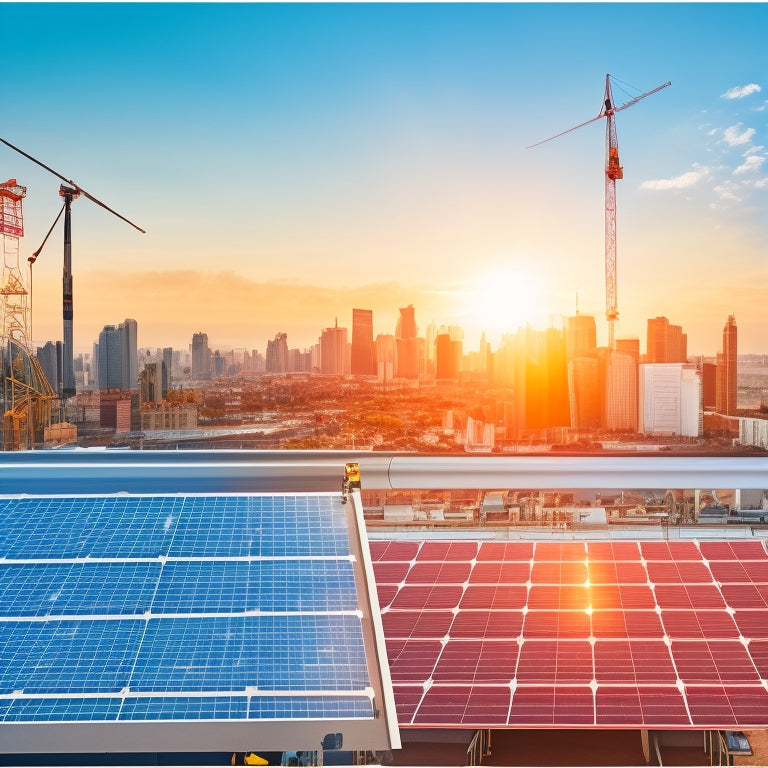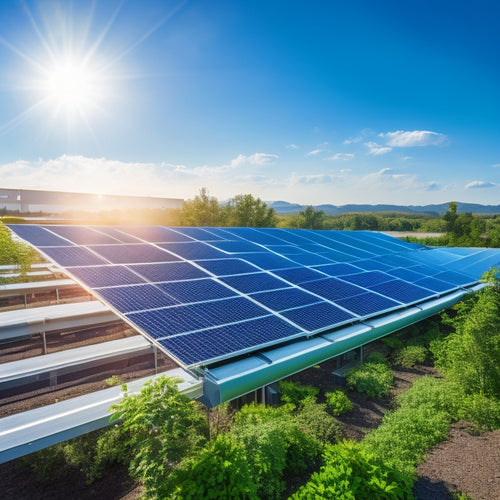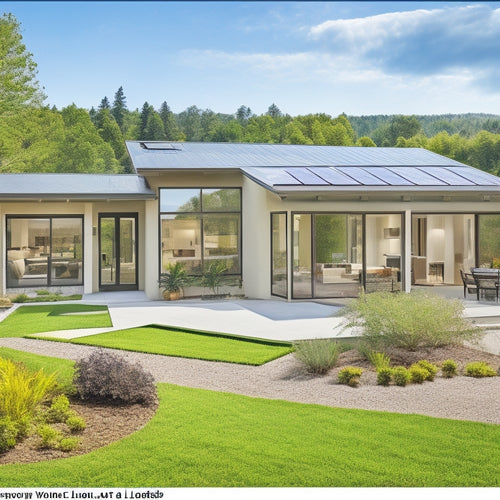
Top 10 Factors Affecting Solar Installation Costs
Share
As you traverse the process of going solar, understanding the intricate array of factors that influence installation costs is essential to making an informed decision, with system size, panel quality, and local labor costs being just a few of the key considerations that can markedly impact your upfront investment and long-term savings. Other vital factors include installation company reputation, roof size and orientation, battery backup and storage, permits and inspection fees, mounting and tracking systems, grid connection and interconnection, and utility regulations. Get a thorough grasp of these factors to optimize your solar investment and uncover the full potential of renewable energy for your unique situation.
Key Takeaways
- System size and complexity directly impact installation costs, with larger systems requiring more materials, labor, and design considerations.
- High-efficiency solar panels reduce overall installation costs by requiring fewer panels, despite higher upfront costs.
- Roof size, orientation, and ideal sun exposure significantly affect solar panel installation costs, with ideal roof sizes accommodating necessary panels.
- Local labor costs, taxes, and installation company reputation influence overall costs, with reputable companies typically charging more for quality and reliability.
- Inverter type and quality, as well as battery backup and storage options, also impact solar installation costs, with premium brands offering better reliability and longer warranties.
System Size and Complexity
Your solar installation project's system size and complexity greatly impact the overall cost. A larger system with more panels and a more intricate system layout requires more materials, labor, and design considerations, driving up costs.
Installation challenges, such as complex roof angles or multiple roof faces, can also increase expenses. Furthermore, larger systems come with higher maintenance requirements, which can add to the total cost.
Financing options, zoning regulations, and technology advancements can also influence the cost of your solar installation. For instance, local governments may offer incentives for larger systems, while technology advancements in panel efficiency can reduce the number of panels needed, thereby decreasing costs.
Additionally, your aesthetic preferences, such as the color and style of the panels, can affect the final cost. By understanding the interplay between system size, complexity, and these factors, you can make informed decisions to optimize your solar installation project's cost and achieve energy independence while minimizing its environmental impact.
Panel Quality and Efficiency
When you're shopping for solar panels, you'll encounter varying levels of quality and efficiency.
High-efficiency panels can greatly reduce the overall cost of your installation by requiring fewer panels to meet your energy needs.
You'll need to evaluate factors like tier 1 vs tier 2 manufacturers, wattage per square foot, and the overall efficiency ratings to make an informed decision.
High Efficiency Matters
As you weigh the options for your solar installation, it's vital to reflect on the quality and efficiency of the panels themselves, as they greatly impact the overall cost of the system.
High-efficiency panels can markedly reduce the number of panels needed to meet your energy requirements, leading to lower installation costs and faster return on investment.
Solar technology advancements have made high-efficiency panels more accessible, offering energy efficiency benefits that translate to long-term savings.
In addition, these panels have a lower environmental impact due to their reduced material usage and increased energy production per unit area.
Government incentives and financing options can also be utilized to offset the higher upfront cost of high-efficiency panels.
Moreover, they require less maintenance and have shorter installation timelines, resulting in lower maintenance costs and faster project completion.
By prioritizing high-efficiency panels, you can optimize your solar installation's performance, reduce costs, and maximize your return on investment.
It's important to educate yourself on the benefits and trade-offs of high-efficiency panels to make an informed decision for your solar project.
Tier 1 Vs Tier 2
The solar panel market is categorized into tiers, with Tier 1 and Tier 2 being the most prominent distinctions. As you consider solar installation, understanding the differences between these tiers is vital for making an informed decision.
Tier 1 solar panels, manufactured by top brands like SunPower and Panasonic, offer superior quality and efficiency. They boast higher performance metrics, such as higher wattage and better temperature coefficients, ensuring maximum energy production. Additionally, Tier 1 brands provide longer warranties, up to 25 years, and have a proven track record of reliability.
In contrast, Tier 2 panels, while still reliable, have lower performance metrics and shorter warranties, typically 10-15 years. While they may be cheaper, the drawbacks of Tier 2 panels can lead to reduced energy production and higher maintenance costs in the long run.
When comparing costs, consider that Tier 1 panels may be more expensive upfront, but their superior quality and efficiency can lead to significant long-term savings.
Market trends suggest that Tier 1 panels are becoming increasingly popular, and installation processes are adapting to accommodate their unique requirements.
Wattage Per Square Foot
Higher wattage ratings per square foot directly impact your solar panel's quality and efficiency, ultimately affecting your energy production and savings. This metric measures the amount of power generated per unit area, which is critical for maximizing your solar installation's performance.
A higher wattage per square foot means you'll need fewer panels to generate the same amount of energy, reducing your overall system cost and increasing your return on investment.
When evaluating solar panels, look for high wattage ratings per square foot to guarantee ideal space utilization. This is particularly important for installations with limited roof space, where every square foot counts.
Higher solar density translates to more energy produced per unit area, making it an essential consideration for those seeking to maximize their energy output.
As you compare solar panels, keep in mind that higher wattage ratings per square foot often come with higher price tags. However, the increased energy production and savings can justify the added upfront cost.
Installation Company Reputation
You're likely to get varying quotes from different solar installation companies, and one key factor influencing these estimates is the company's reputation. A reputable installation company with a proven track record of successful projects will generally charge more than a lesser-known company. This is because they've invested in their team's installation training, have a strong warranty program, and offer reliable post-installation support.
When evaluating a company's reputation, consider the following:
-
Installation experience: How many projects have they completed, and what's their success rate?
-
Customer reviews: What do their previous customers say about their service and work quality?
-
Warranty options: What kind of warranty do they offer, and how long does it last?
-
Service reliability: How quickly do they respond to maintenance requests or issues?
-
Company transparency: How open are they about their project timelines, costs, and expectations?
A reputable installation company may charge more upfront, but they'll likely provide better service, higher-quality equipment, and a smoother installation process. This can lead to greater long-term savings and a more reliable solar energy system.
Roof Size and Orientation
When you assess your roof for solar installation, you'll need to take into account the available roof space to determine how many panels can fit.
The ideal roof size for solar installation is one that can accommodate the necessary number of panels to meet your energy needs.
Additionally, you'll want to evaluate your roof's orientation to guarantee it receives ideal sun exposure, which is typically south-facing with minimal shading.
Roof Space Availability
Determining the feasibility of a solar installation project begins with evaluating the roof space availability, a critical factor that considerably impacts the overall cost.
You'll need to assess whether your roof can accommodate the required number of solar panels to meet your energy needs. Consider the roof pitch, as a steeper pitch may require more complex installation, increasing costs.
Additionally, take note of:
- Shading issues: nearby trees, buildings, or structures that cast shadows on your roof, reducing energy output
- Structural integrity: verify your roof can support the weight of the solar panels and withstand local weather conditions
- Local regulations: comply with building codes, permits, and zoning laws that may affect your installation
- Maintenance requirements: consider the accessibility of your roof for future cleaning and repairs
- Future expansion: plan ahead for potential upgrades or additions to your solar installation
Ideal Sun Exposure
Across the roof's surface, ideal sun exposure hinges on two significant factors: size and orientation. You'll want to guarantee your roof receives peak solar access to maximize energy consumption. A shading analysis will help identify areas with limited sunlight, allowing you to adjust your installation accordingly.
Seasonal variations also play a vital role, as sunlight intensity differs throughout the year. Your geographical location and local climate will influence the amount of sunlight your roof receives, making it important to take into account these factors when planning your installation.
The timing of your installation is also critical, as weather patterns can impact the effectiveness of your solar panels. For instance, installing during the summer months can enhance energy production.
The type of roof material you have will also affect sunlight absorption, with some materials absorbing more sunlight than others. By taking these factors into account, you can enhance your roof's sun exposure and maximize your energy output.
Local Labor Costs and Taxes
Your solar installation project's bottom line is heavily influenced by local labor costs and taxes, which can vary greatly depending on your location.
These factors can greatly impact the overall cost of your solar installation, making it essential to take them into account when planning your project.
Local wage trends play a considerable role in determining labor costs. Areas with higher costs of living tend to have higher labor costs, which are then passed on to you, the consumer.
Additionally, tax incentives, such as local and state tax credits, can also affect the final cost of your solar installation.
Some key factors to take into account when evaluating local labor costs and taxes include:
- Local wage trends and how they impact labor costs
- Availability of tax incentives, such as local and state tax credits
- Property tax exemptions or reductions for solar installations
- Sales tax rates and exemptions for solar equipment
- Permitting and inspection fees, which can vary by jurisdiction
Inverter Type and Quality
When selecting an inverter for your solar installation, you'll encounter different efficiency ratings, which impact the overall system's energy production.
You'll also need to decide between premium and economy brands, each with their own trade-offs regarding cost, performance, and warranty.
Understanding the differences between these options is essential to balancing your system's energy output with your budget.
Inverter Efficiency Ratings
The inverter, an indispensable component in any solar panel system, plays a key role in converting DC power from the panels into AC power for your home or business.
You'll want to verify you're getting the most efficient inverter for your system.
Inverter efficiency ratings are vital, as they directly impact the amount of energy your system produces. A higher efficiency rating means more power for you to use or feed back into the grid.
When selecting an inverter, consider the following factors:
- Look for inverters with high efficiency ratings (95% or higher) to minimize energy loss.
- Check the inverter's maximum power point tracking (MPPT) to guarantee it can optimize energy production.
- Consider inverters with advanced cooling systems to prolong their lifespan.
- Research inverters with smart monitoring capabilities to track your system's performance.
- Be aware that higher-efficiency inverters often come with a higher price tag, so weigh the costs against the benefits.
Premium Vs. Economy Brands
Frequently, homeowners and businesses opting for solar installations find themselves at a crossroads when it comes to selecting an inverter brand, torn between premium and economy options.
You'll need to evaluate the benefits of each to make an informed decision. Premium brands offer superior brand reliability, longer warranty options, and exceptional customer service. Their products typically have a longer lifespan, which translates to increased energy savings over time.
Additionally, premium brands often stay ahead of market trends, incorporating technology advancements that improve system performance. While they come at a higher upfront cost, financing options may be available to offset the expense.
Economy brands, on the other hand, offer a more affordable entry point, but may compromise on brand reputation, installation support, and overall quality.
You'll need to assess your budget and priorities to determine which type of brand is right for you.
Battery Backup and Storage
Beyond the panels, an essential aspect of your solar installation is battery backup and storage. This component allows you to store excess energy generated during the day for use during the night or when the grid is down.
With a battery backup system, you can enjoy energy independence and reduce your reliance on the grid.
When it comes to battery backup and storage, you have several options to reflect upon:
- Deep cycle batteries: designed to provide a steady flow of energy over a long period
- Lithium-ion batteries: offer high energy density and a long lifespan
- Flow batteries: ideal for long-duration energy storage
- Lead-acid batteries: a cost-effective option for small-scale energy storage
- Sodium-ion batteries: a newer technology with promising performance and cost savings
Permits and Inspections Fees
Before you can flip the switch on your solar installation, you'll need to secure the necessary permits and pass inspections, which come with associated fees.
Permit requirements vary by jurisdiction, but typically include electrical, building, and zoning permits. You'll need to submit applications, pay fees, and provide documentation, such as system design plans and equipment specifications, to comply with local regulations.
Inspection processes involve reviewing your installation to guarantee it meets inspection standards. Timelines for application and inspection vary, but expect delays if your application is incomplete or non-compliant.
Permit costs and fee structures differ by locality, but you can expect to pay several hundred to several thousand dollars, depending on the complexity of your installation.
To avoid permit delays and compliance issues, ascertain you understand local regulations and documentation needs. Plan accordingly, and factor these costs into your overall installation budget.
Mounting and Tracking Systems
Once you've secured the necessary permits, your focus shifts to the physical installation of your solar panels, which relies heavily on mounting and tracking systems.
These components play a critical role in ensuring your solar panels operate at maximum efficiency.
The type and quality of mounting materials you choose will directly impact your installation costs. For instance, using high-quality, durable materials can increase your upfront costs but provide long-term savings through reduced maintenance needs.
On the other hand, opting for lower-cost materials may lead to increased maintenance and replacement expenses down the line.
Some key considerations when it comes to mounting and tracking systems include:
- Tracking technology: Does the system use single-axis or dual-axis tracking to optimize energy production?
- Mounting materials: Are they durable, weather-resistant, and designed for your specific climate and roof type?
- Adjustability: Can the system be easily adjusted to accommodate changing seasonal angles?
- Integration: How seamlessly does the mounting and tracking system integrate with your solar panels and inverters?
- Warranty and support: What kind of warranty and support does the manufacturer offer for the mounting and tracking system?
Grid Connection and Interconnection
Reliability is paramount when it comes to connecting your solar panel system to the grid, as a seamless grid connection and interconnection are essential for feeding excess energy back into the grid and offsetting your utility bills.
You need to verify that your system meets the interconnection standards set by your utility company, which may require system upgrades to guarantee grid stability.
Utility regulations and connection fees will impact your installation costs. You'll need to pay fees for connecting to the grid, which vary depending on the utility company and your system's size.
Additionally, you may need to enter into service agreements or power purchase agreements, which can affect your costs. However, some utility companies offer incentives for solar installations, such as net metering, which can offset your utility bills.
To verify a smooth interconnection, you'll need to comply with utility regulations and meet the necessary standards for grid connection.
Frequently Asked Questions
Can I Install Solar Panels on a Rented Property?
You'll need to review your renter agreements to determine if installing solar panels is allowed, and obtain installation permissions from your landlord before proceeding with the project, ensuring a harmonious and legal process.
Are There Any Government Incentives for Solar Installation?
As you shine a light on solar installation, you'll uncover a wealth of government incentives! You can claim a federal tax credit of up to 26% of the total cost, plus state rebates, greatly reducing your upfront expenses.
How Long Does a Typical Solar Installation Project Take?
You'll typically spend 2-6 months planning and executing a solar installation project, with the actual installation timeline ranging from a few days to several weeks, depending on the project's complexity and your local permitting process.
Can Solar Panels Be Installed on a Metal Roof?
You can install solar panels on a metal roof, leveraging its advantages like durability and water-tightness, but you'll face installation challenges like ensuring secure fastening and accommodating roof ribs, requiring specialized skills and equipment.
Do Solar Panels Work During a Power Outage?
You're probably wondering, like Archimedes, if solar panels can still shine during a power outage. The answer lies in off-grid systems with battery storage, allowing you to capture energy even when the grid goes dark.
Conclusion
As you weigh the costs of going solar, remember that each of these 10 factors is a thread in the intricate fabric of your installation's final price. Like a skilled weaver, you must carefully consider each strand to create a beautiful, affordable, and efficient system that illuminates your path to energy independence. By doing so, you'll reveal the full potential of solar power and bask in the warmth of significant savings.
Related Posts
-

Integrating Smart Technology for Energy Savings
Integrating smart technology into your home is a transformative factor for energy savings. Smart thermostats give you...
-

Solar Energy Efficiency Improvements for Businesses
Improving solar energy efficiency for your business can lead to considerable cost savings and enhance your sustainabi...
-

Passive Solar Design Strategies for Homes
To effectively implement passive solar design strategies in your home, focus on ideal building orientation and strate...


